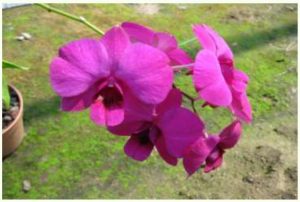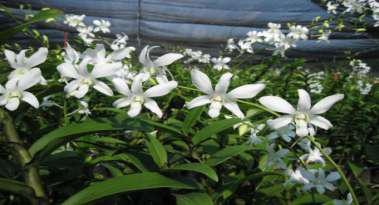By Tommy Clarkson from the February 2011 Edition
Family: Orchidaceae
Right now, I’ve a lot of information with too little time and space! Firstly, the genus whole of orchids is the second largest family of flowering plants having between 22,000 and 27,000 currently accepted species in 880 genera not counting more than 50,000 registered hybrids! Today’s featured species, Dendrobiums, has perhaps 1,500 species in this genus alone. That’s a lot to cover! But, with a goal of moderate brevity, into the task we plunge!
While the shape and form of Dendrobium stems and leaves vary greatly, the pattern of flowers is fairly constant ranging from smaller than a tiny matchbox to large, robust specimens that measure more than one meter. With that most simplistic base, here now are three initial, background, nuggets of knowledge regarding these most magnificent of tropical flowers:
(1) Their origin is a diversity of habitats ranging from much of southern and eastern Asia to include the Philippines, Australia, Borneo, New Guinea, New Zealand, the Philippines, and the Solomon Islands. A well adapted genus, they thrive in as diverse climates as the high altitudes in the Himalayan mountains to lowland tropical forests and, remarkably, even the dry climate of the Australian desert. Right from the outback, eh, mate!
(2) The name, Dendrobium, stems from the Greek word dendron (“tree”) and bios life”) thus meaning “one who lives on trees.” (No, Tarzan was not a Dendrobium!)
(3) Lastly, in this trivia trio, is the fact that this genus was first identified and established by the Swedish botanist Olof Peter Swartz (September 21, 1760 – September 19, 1818). I’m not sure, but we may have gone to college together!
My first personal experience with Dendrobiums came a few years back when I owned and operated Coconut Post in multiple locations throughout Hawaii. These were one of the various products we sold from our retail outlets. More recently, I learned of “Viveplants orchids and exotics”, just north of Manzanillo, run by a most exceptional young businessman, Fidel Maza. While touring his impeccably groomed operation, I learned that his company offers a wide array of high quality, very competitively priced, orchid species both cut and potted. So well organized is he that in but seven years he now provides more than half of the orchids consumed over all of Mexico.
Beyond selling throughout this republic he is now expanding to international markets in Central and South America as well as Europe. His products are numerous species of Dendrobium hybrids and a diverse array of Oncidium, Phalenopsis, Vanda, and Ascocenda Orchids. (Along with orchid planting and growing tips, more on these species in later columns)
Some more “nuts and bolts” data on the Dendrobiums species is that they are either epophytic or lithophytic. The former means that they, non-parasitically, grow on other plants (such as a tree) or other objects and derive their moisture and nutrients from the air and rain. The latter are plants that grow on rocks, feeding off moss and deriving its nutrients from rain, litter, and its own dead tissue.
A fact upon which “Viveplants” is well and justifiably capitalizing, Dendrobiums are commonly used as cut flowers because of their sturdy stems and distinctive coloring. . . to say nothing of their startlingly brilliant blooms ranging from subtly subdued to vibrantly vivid. they are planted in well draining, well aerated potting soil.
(That “well draining” part is very important as too much standing moisture can cause crown rot.) If used as an indoor plant, keep an eye out for spider mites or scale if plant is stressed.
During the warmer summertime, feed once a month with a balanced, soluble plant food. And in order to have the best presentation, cut away dead and dying leaves and wipe off the leaves every now and again to enjoy the full majesty of their beauty.
By whatever name you decide to call them, they are a wonderful addition to your garden!

Download the full edition or view it online
—
Tommy Clarkson is a bit of a renaissance man. He’s lived and worked in locales as disparate as the 1.2 square mile island of Kwajalein to war-torn Iraq, from aboard he and Patty’s boat berthed out of Sea Bright, NJ to Thailand, Germany, Hawaii and Viet Nam; He’s taught classes and courses on creative writing and mass communications from the elementary grades to graduate level; He’s spoken to a wide array of meetings, conferences and assemblages on topics as varied as Buddhism, strategic marketing and tropical plants; In the latter category he and Patty’s recently book, “The Civilized Jungle” – written for the lay gardener – has been heralded as “the best tropical plant book in the last ten years”; And, according to Trip Advisor, their spectacular tropical creation – Ola Brisa Gardens – is the “Number One Tour destination in Manzanillo”.




You must be logged in to post a comment.